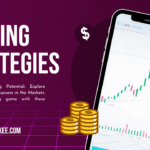Introduction: How to Trade Cryptocurrency as a Beginner
If you’re wondering how to trade cryptocurrency as a beginner, you’re not alone. With Bitcoin, Ethereum, and altcoins making headlines, many newcomers are eager to dive into crypto trading. But with thousands of digital assets and a fast-moving market, it can be overwhelming.
In this beginner-friendly guide, we’ll walk you through everything you need to know—without the jargon. You’ll discover how to pick the right platform, avoid common pitfalls, and trade like a pro (even if you’re starting from scratch).
What Is Cryptocurrency Trading?
Cryptocurrency trading involves buying and selling digital currencies on exchanges to profit from market movements. You can trade popular coins like Bitcoin (BTC), Ethereum (ETH), or emerging altcoins.
Unlike traditional stock markets, crypto trades 24/7. This means opportunities (and risks) are always present. Understanding how to trade cryptocurrency as a beginner is your first step toward navigating this dynamic market.
Step 1: Understand the Basics
Before you invest a dollar, you need a solid foundation.
What Is a Cryptocurrency Exchange?
A crypto exchange is like a stock market for digital assets. Here, you can buy, sell, or hold cryptocurrencies.
Top Exchanges for Beginners:
Each platform has its own features, fees, and supported coins.
Types of Trading
- Spot Trading: Buying coins at current market prices.
- Margin Trading: Trading with borrowed funds (high risk).
- Futures Trading: Speculating on price direction without owning the coin.
Pro Tip: Stick to spot trading if you’re just starting out.
Step 2: Set Up a Secure Wallet
You need a crypto wallet to store your assets safely. There are two main types:
Hot Wallets (Online)
- Fast access for trading
- Ideal for active users
Cold Wallets (Offline)
- Best for long-term holders
- Offers high-level security
Example: Ledger Nano X is a popular cold wallet.
Which Wallet Should Beginners Choose?
For those learning how to trade cryptocurrency as a beginner, a hot wallet integrated with a trusted exchange like Coinbase is a simple and secure starting point.
Step 3: Choose the Right Exchange for You
Here are a few questions to ask:
- Is the platform regulated?
- What fees are charged per trade?
- Does it support fiat currency deposits?
Tradexee is designed with beginners in mind, offering user-friendly tools, easy onboarding, and a growing library of educational content.
Step 4: Fund Your Account
Most platforms let you deposit via:
- Bank transfer
- Debit/credit card
- PayPal or other e-wallets
Check fees before you deposit—some methods are costlier than others.
Tip: Start with a small deposit ($50–$100) while you’re still learning the platform.
Step 5: Start with a Small Trade
Once your account is funded, start trading—but don’t go all in.
How to Place a Trade:
- Choose a trading pair (e.g., BTC/USD)
- Decide your order type:
- Market Order: Buy/sell at current price
- Limit Order: Set your desired price
- Click “Buy” or “Sell”
Expert Insight: “Start small and learn the ropes. Emotion is the enemy of smart trading,” says crypto educator Sarah Kim.
If you’re practicing how to trade cryptocurrency as a beginner, begin with just 1–2 trades per week while you learn.
Essential Tips for Beginner Traders
1. Only Invest What You Can Afford to Lose
Crypto is volatile. Protect your capital.
2. Don’t Chase Hype
Coins that suddenly skyrocket usually crash just as fast.
3. Learn to Read Charts
Basic technical analysis can help you identify trends and entry/exit points.
4. Practice With a Demo Account
Several exchanges offer demo modes—use them before risking real money.
5. Use Stop-Loss Orders
They help limit losses by automatically selling at a preset level.
6. Follow Crypto News Daily
Staying updated on news helps inform your trades. Sites like CryptoCompare and CoinMarketCap are great resources.
How to Avoid Common Mistakes
FOMO (Fear of Missing Out)
Jumping into a trade just because a coin is trending often leads to losses.
Poor Research
Never trade based on a tweet or rumor. Always do your own due diligence.
Ignoring Security
Use 2FA, avoid public Wi-Fi, and don’t share your private keys.
Trading Without a Strategy
One of the key lessons in how to trade cryptocurrency as a beginner is to create a simple plan and stick to it. Set your entry, exit, and stop-loss points.
Real-Life Example: How Mark Turned $500 into $1,800
Mark, a 26-year-old graphic designer, started trading on Tradexee with just $500. After 3 months of learning technical analysis and using limit orders, he exited a well-timed ETH trade with $1,800.
His secret? Patience, research, and never risking more than 5% of his capital per trade. He also spent time on forums and watched YouTube tutorials to enhance his learning.
Crypto Trading Terms You Should Know
Bull Market
A period when prices are rising
Bear Market
A period when prices are falling
HODL
“Hold on for dear life” – a long-term investment strategy
Altcoin
Any coin that isn’t Bitcoin
DCA (Dollar-Cost Averaging)
A strategy of investing small amounts regularly instead of a lump sum
Volume
The number of coins traded in a specific time frame
FAQs: How to Trade Cryptocurrency as a Beginner
What is the best crypto exchange for beginners?
Platforms like Coinbase, Binance, and Tradexee are beginner-friendly and offer solid educational support.
How much money do I need to start trading?
You can start with as little as $10. It’s more about learning than big gains early on.
Is trading crypto legal?
In most countries, yes. But always check local regulations before you trade.
Can I make a living from trading crypto?
Some do, but it takes time, strategy, and risk management. It’s not a get-rich-quick scheme.
What’s the safest strategy for a beginner?
Start with spot trading and use dollar-cost averaging. Avoid leverage and always use a stop-loss.
Final Thoughts
Learning how to trade cryptocurrency as a beginner is exciting—and a bit intimidating. But with the right tools, mindset, and strategy, you can navigate the crypto landscape confidently.
Start small, stay informed, and focus on sustainable growth. Check out more trading insights, tips, and platform tools at Tradexee.
External Resources for Further Learning:


